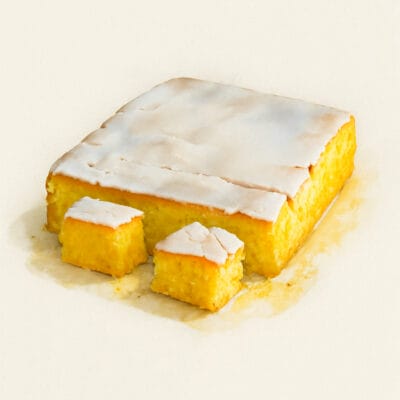Bolinhol de Vizela: Um Tesouro de Confeitaria de Portugal
O Bolinhol de Vizela é um bolo de ló tradicional português que faz parte do património gastronómico de Vizela há mais de 130 anos, com as suas origens a remontarem a 1884. Este bolo incrivelmente leve e arejado é feito com apenas três ingredientes simples – ovos, farinha e açúcar – mas alcança uma fofura notável sem qualquer fermento ou levedura. O desenvolvimento do bolo coincidiu com o crescimento do termalismo em Vizela, atraindo especialmente ricos comerciantes ingleses envolvidos no comércio de vinho do Porto e turistas espanhóis que vinham desfrutar das termas. O formato retangular deste bolo de ló coberto foi oficialmente registado pelo Instituto Nacional da Propriedade Industrial em 1921, consolidando a sua identidade única.
Bolinhol de Vizela

Um bolo de ló tradicional de Vizela que é incrivelmente leve e fofo, feito apenas com ovos, farinha e açúcar. Esta receita de 130 anos cria uma textura arejada sem qualquer agente levedante.
Ingredients
- 12 ovos grandes, separados
- 300 g de açúcar em pó
- 300 g de farinha de trigo, peneirada
- Manteiga para untar
- Farinha para polvilhar
Directions
- Pré-aqueça o forno a 180°C. Unte e polvilhe com farinha uma forma retangular.
- Separe as claras das gemas, colocando as claras numa tigela grande e limpa e as gemas noutra.
- Bata as claras em castelo até obter picos firmes.
- Numa tigela separada, bata as gemas com o açúcar até obter uma mistura clara e cremosa.
- Incorpore delicadamente a farinha peneirada na mistura de gemas, usando uma espátula.
- Adicione cuidadosamente as claras em castelo em três partes à mistura. Dobre-as com cuidado para manter a textura arejada e fofa.
- Despeje a massa na forma preparada e leve ao forno por cerca de 45 minutos, ou até que fique dourada e elástica ao toque.
- Deixe arrefecer na forma por 10 minutos antes de desenformar para uma grade de arame para arrefecer completamente.
- A Paciência no Bater das Claras: A chave para a leveza do Bolinhol reside em bater as claras até ficarem bem firmes. Este passo é crucial para a textura final, uma vez que a receita não usa fermento.
- Incorporar com Delicadeza: Ao misturar as claras batidas na massa, o segredo é fazê-lo com movimentos suaves para não perder o ar.
- Servir: O Bolinhol é tipicamente servido coberto com glacê ou simplesmente polvilhado com açúcar em pó, mas a versão mais tradicional é servida sem cobertura.
- Aparência Rústica: Não se preocupe se o bolo não ficar perfeitamente liso no topo; a sua aparência rústica faz parte do seu encanto.
Nutrition
Por Porção: 250 calorias; 8 g de gordura; 35 g de hidratos de carbono; 10 g de proteína; 180 mg de colesterol; 40 mg de sódio.
—
Bolinhol de Vizela: A Confectionery Treasure of Portugal
Bolinhol de Vizela is a traditional Portuguese sponge cake that has been part of Vizela’s gastronomic heritage for over 130 years, with its origins dating back to 1884. This incredibly light and airy cake is made with just three simple ingredients – eggs, flour, and sugar – yet achieves a remarkable fluffiness without any yeast or leavening agents. The cake’s development coincided with the growth of thermal tourism in Vizela, attracting wealthy English merchants involved in the Port wine trade and Spanish tourists who came to enjoy the thermal baths. The rectangular shape of this glazed sponge cake was officially registered by the National Institute of Industrial Property in 1921, solidifying its unique identity.
Bolinhol de Vizela

A traditional Portuguese sponge cake from Vizela that is incredibly light and fluffy, made with only eggs, flour, and sugar. This 130-year-old recipe creates an airy texture without any leavening agents.
Ingredients
- 12 large eggs, separated
- 300 g (1 1/2 cups) granulated sugar
- 300 g (2 1/4 cups) all-purpose flour, sifted
- Butter for greasing
- Flour for dusting
Directions
- Preheat the oven to 180°C (350°F). Grease and flour a rectangular baking tin.
- Separate the egg whites and yolks, placing the whites in a large, clean bowl and the yolks in another.
- Beat the egg whites until stiff peaks form.
- In a separate bowl, beat the egg yolks with the sugar until the mixture is pale and creamy.
- Gently fold the sifted flour into the egg yolk mixture using a spatula.
- Carefully fold in the beaten egg whites in three additions, using a gentle folding motion to maintain the airy and fluffy texture.
- Pour the batter into the prepared tin and bake for about 45 minutes, or until golden and springy to the touch.
- Let the cake cool in the tin for 10 minutes before turning it out onto a wire rack to cool completely.
- The Patience of Beating Egg Whites: The key to the lightness of the Bolinhol is beating the egg whites until they are very stiff. This step is crucial for the final texture, as the recipe does not use any leavening agents.
- Fold Gently: When mixing the beaten egg whites into the batter, the secret is to do it with gentle movements to avoid losing the air you’ve incorporated.
- Serving: The Bolinhol is typically served covered with a glaze or simply dusted with powdered sugar, but the most traditional version is served plain.
- Rustic Appearance: Don’t worry if the cake doesn’t have a perfectly smooth top; its rustic appearance is part of its charm.
Nutrition
Per Serving: 250 calories; 8 g fat; 35 g carbohydrates; 10 g protein; 180 mg cholesterol; 40 mg sodium.